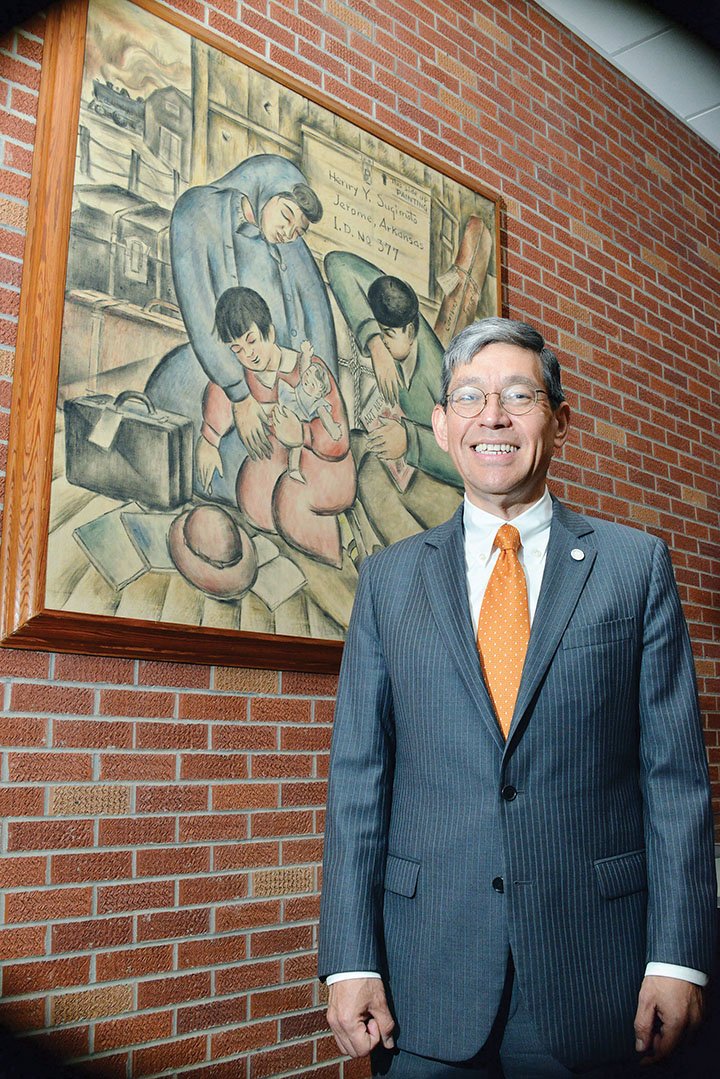When Bill Tsutsui got a campus tour from students on his first official trip to Hendrix College in 2013 just before he was announced as president, he saw something that stopped him in his tracks.
They were in the Mills Center, and he noticed a large piece of art hanging on the wall.
“All of a sudden, I freaked out,” Tsutsui said. “I said, ‘That’s an internment piece. That’s a Sugimoto.’”
It was Henry Sugimoto’s artwork titled Arrival at Camp Jerome.
Tsutsui and his wife, Marjorie Swann, are art collectors. Tsutsui is also a Japanese-American, and his Japanese father, who came to the United States after World War II, told him about the internment camps that were instituted during the war. Thousands of Japanese-Americans, the majority of whom were U.S. citizens, were forced from their homes. Two of the camps were in Arkansas — Jerome and Rohwer in southeast Arkansas. Sugimoto and his family were interned at Camp Jerome, then at Rohwer.
Tsutsui said his strong reaction to the painting surprised the students.
“I said, ‘This is a treasure in your midst.”’ Few people on campus, much less in Arkansas, knew of the artist, he said. Many U.S. citizens aren’t aware that Arkansas had internment camps, he said.
When Tsutsui further inquired about the artwork and how it came to be at Hendrix College, he was given an article written in 1994 by Hendrix professor Bob Meriwether, who died in 2010.
“It was just an eye-opener,” Tsutsui said.“The story was better than I could even have imagined.”
That’s why the 1943 painting will be commemorated at 4:30 p.m. Friday in the Mills Center as part of Tsutsui’s inauguration schedule. Tsutsui will be inaugurated at 2 p.m. Saturday on the west lawn of Ellis and Fausett halls.
The president said Sugimoto’s daughter, Madeleine, who is near 80 years old and lives in New York, will attend the ceremony.
“I talked with her on the phone. She’s such a sweet, elegant person,” Tsutsui said.
Hendrix had a monthlong exhibition of Sugimoto’s work during World War II, a bold move for the times.
“It’s symbolic of the kind of culture we have at Hendrix and have had for decades,” Tsutsui said.
Meriwether, who was editor of Faulkner County Facts and Fiddlings, a publication of the Faulkner County
Historical Society, wrote that two Hendrix College art professors visited the Jerome Relocation Center. They saw Sugimoto’s artwork — he taught art at the camp’s high school — and were impressed.
Sugimoto was asked to display his work at Hendrix, and the Jerome camp director gave his blessing.
A one-man show of Sugimoto’s artwork was on display in the Hendrix Library, which is now the Buhler Biology Building, during February 1944. Meriwether’s research showed that the exhibit opened the same day the U.S. government released a report “on the very brutal treatment of American prisoners of war captured by the Japanese on Battan and Corregidor in the Philippines in 1942.”
Meriwether wrote that the outrage of Americans “no doubt prompted Hendrix officials to emphasize in news releases that Sugimoto and his wife were ‘loyal Christian Americans’” and that the paintings portrayed camp life “with no bitterness, much tenderness and occasional humor.”
At the end of the exhibit, Hendrix purchased Sugimoto’s portrait of his family arriving at Camp Jerome.
“We need to raise the profile” of the painting, Tsutsui said. “From the time I arrived, I knew we needed to do something.” Tsutsui first suggested moving the art to the president’s office so everyone who came in would see it. He decided that the Mills Center has a lot of traffic, so the artwork has visibility, but it needed an interpretive plaque. “It’s just hanging there,” Tsutsui said, still incredulous that such a piece of history was underplayed.
Hendrix Art Department Chairman Rod Miller, an art historian, also commented on the painting.
“We have maybe four or five paintings on the campus that are exceptional, and this is one,” Miller said.
“Arrival at Camp Jerome demonstrates Sugimoto’s knowledge of contemporary painting and his subtlety in using elements of Futurism, a style typically used for images of machines and movement, to communicate a specific historic moment and very traditional themes of family and suffering,” Miller said.
Tsutsui said the commemoration of the painting worked out perfectly.
“It just all came together, and things came together in a weird way,” Tsutsui said.
He is friends with former U.S. Sen. Daniel Inouye’s widow, Irene Hirano Inouye, who will speak at 6 p.m. today at the Clinton School of Public Service in Little Rock and will attend Tsutsui’s inauguration. He said Inouye was talking about the Hendrix event to someone, who turned out to be the lawyer for Sugimoto’s estate. The lawyer said he knew Sugimoto’s daughter and suggested that Hendrix invite her to the commemoration of the painting. Inouye will also speak at the commemoration of the painting.
Tsutsui said that when he talked to Madeleine Sugimoto, she told him she remembered coming to Hendrix for the exhibition as a child, “which is just amazing.” She is depicted in her father’s artwork, holding a doll.
Most of Sugimoto’s work is in the Japanese American National Museum in Los Angeles, which is where Tsutsui said he first saw the artist’s work.
“I said, ‘Ah, I’d love to have one of those paintings.’ Now I do, collectively,” Tsutsui said, laughing.
Senior writer Tammy Keith can be reached at (501) 327-0370 or tkeith@arkansasonline.com.
